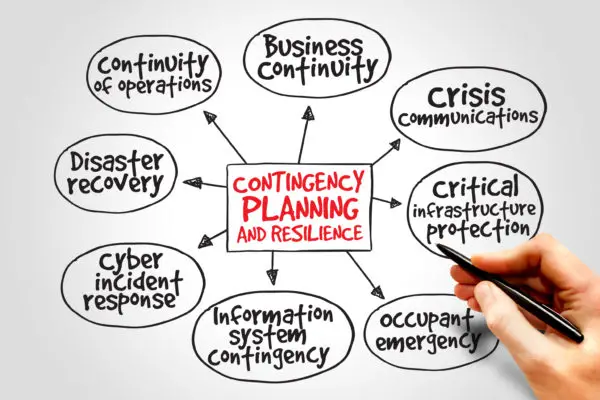A business continuity plan consists of five key steps to guarantee organizational resilience. First, conduct a thorough risk assessment to identify and mitigate potential threats.
Second, perform a business impact analysis to understand critical functions and dependencies. Third, identify and prioritize critical systems to minimize downtime.
Fourth, implement a robust data backup strategy to safeguard essential information. Lastly, develop recovery plans and regularly test them to guarantee effective post-disaster restoration.

Discover insights into safeguarding your business from disruptions by exploring the essential elements of a business continuity plan.
Key Takeaways
- Conduct a thorough risk assessment to identify potential threats.
- Develop mitigation strategies to proactively address risks.
- Prioritize risk areas to efficiently allocate resources.
- Perform a Business Impact Analysis to identify critical functions.
- Implement a recovery plan and regularly test its functionality.
Risk Assessment and Mitigation
Effective business continuity planning begins with a thorough risk assessment to identify potential threats that could disrupt operations.
By developing mitigation strategies, organizations can proactively address these risks and minimize their impact.
Prioritizing risk areas guarantees that resources are allocated efficiently to safeguard critical functions and maintain resilience in the face of adversity.
Identify Potential Threats
An essential first step in creating a business continuity plan is the thorough identification of potential threats through rigorous risk assessment and mitigation strategies.
Effective business continuity plans hinge on the in-depth understanding and listing of potential threats that could disrupt business operations.
These threats encompass a wide spectrum, including natural disasters, cyberattacks, ransomware, human errors, and unplanned downtime.
By proactively mitigating these risks, organizations can greatly reduce the impact of disruptions, safeguarding their business continuity and resilience.
Addressing potential threats through robust risk mitigation strategies not only enhances the overall preparedness of the business but also ensures a more effective response to unforeseen challenges, ultimately strengthening the foundation for sustained operations.
Develop Mitigation Strategies
Addressing potential threats through robust risk mitigation strategies is fundamental in developing effective mitigation strategies for a business continuity plan.
Mitigation strategies involve identifying and reducing vulnerabilities to enhance resilience and preparedness, safeguarding critical business functions from disruptions.
Risk assessment plays a vital role in understanding the likelihood and impact of various risks, guiding the implementation of mitigation measures to minimize negative consequences.
By implementing mitigation strategies based on thorough risk assessment, businesses can increase their ability to withstand and recover from threats. Here is a table outlining key aspects of developing mitigation strategies:
| Aspects | Description | Importance |
|---|---|---|
| Risk Assessment | Identifying potential threats and risks | Essential for planning and preparedness |
| Vulnerability Reduction | Addressing weaknesses in systems and processes | Enhances overall resilience |
| Critical Functions Protection | Ensuring essential business functions are safeguarded | Minimizes impact of disruptions |
Prioritize Risk Areas
In the process of risk assessment and mitigation, prioritizing risk areas is vital for identifying and addressing potential threats to business operations.
Businesses must assess and rank likely threats such as natural disasters, cyberattacks, human error, and unplanned downtime to prioritize areas for risk mitigation efforts in their business continuity plan.
Effective risk mitigation strategies play an important role in protecting business revenues, reputation, and overall continuity. By focusing on prioritized risk areas, organizations can better allocate resources and efforts to enhance resilience against disruptions.
Prioritizing risk areas guarantees that mitigation measures are appropriately tailored to address the most critical threats, increasing the organization’s ability to withstand and recover from adverse events with minimal impact on operations and continuity.

Business Impact Analysis
Business Impact Analysis is an essential step in a Business Continuity Plan as it helps identify critical business functions and their dependencies.
Through this analysis, organizations can quantify the impact of disruptions on revenue, expenses, and operations to better understand the consequences.
Insights gained from the analysis guide the prioritization of resources and recovery strategies based on the severity of the impact.
Impact Assessment Importance
Conducting a thorough Business Impact Analysis (BIA) is essential for organizations to understand the critical functions and vulnerabilities that may significantly impact their operations during disruptions.
The BIA helps in identifying important business functions, key employees, and potential regulatory impacts.
By evaluating lost revenues, increased expenses, and establishing Recovery Time Objective (RTO) and Recovery Point Objective (RPO), business owners can effectively plan for continuity and recovery.
This analysis plays a crucial role in creating a business continuity plan that includes strategies for disaster recovery, data backup, and emergency response.
Organizations can utilize resources like Ready.gov to guide them through the process of conducting a detailed Business Impact Analysis, ensuring readiness for unforeseen challenges.

Disruption Consequences Understanding
Understanding the impact of disruptions on critical business functions is essential to developing a thorough business continuity plan.
Business Impact Analysis (BIA) plays an important role in this process by identifying and prioritizing essential services, resources, and dependencies within the organization.
It assesses the financial, operational, and reputational impacts that disruptions can have on the business, guiding the establishment of Recovery Time Objectives (RTOs) and Recovery Point Objectives (RPOs) to shape recovery strategies.
Ready.gov offers tools and resources for conducting a detailed BIA during Business Continuity Plan (BCP) development, ensuring that organizations are well-prepared to mitigate the consequences of disruptions effectively.
Conducting a BIA is a fundamental step towards understanding the full scope of potential impacts and planning appropriate responses.
Recovery Prioritization Insights
Recovery prioritization insights gained through Business Impact Analysis are essential for identifying and focusing on critical business functions in need of immediate recovery efforts.
By conducting a thorough business impact analysis, businesses can pinpoint elements with high-risk potential, ensuring the mitigation of disruptions’ impact.
This analysis also addresses management succession and key employee roles to maintain operational continuity. Additionally, Business Impact Analysis aids in establishing recovery time objectives (RTOs) and recovery point objectives (RPOs) for efficient recovery planning.
Leveraging resources such as Ready.gov tools can streamline the process of conducting a detailed business impact analysis, enabling organizations to prioritize their recovery efforts effectively and enhance their overall resilience in the face of unforeseen events.
Critical Systems Identification
Critical Systems Identification is an essential step in a business continuity plan. It involves the identification and prioritization of key systems and functions essential for operations.
By mapping out the network, hardware, and software topology, organizations can understand the critical components that require protection and swift recovery measures.
Prioritizing these systems guarantees minimal downtime and effective maintenance of business continuity in times of disruption.
Key Systems Prioritization
Identification of mission-critical systems and functions within an organization is a fundamental aspect of ensuring operational resilience and continuity. When prioritizing systems in a business continuity plan, the following steps are essential:
- Map out network, hardware, and software topology: Understand dependencies and vulnerabilities.
- Prioritize protection strategies: Identify systems essential for business operation.
- Implement recovery strategies: Ensure efficient recovery during disruptions.
- Focus on key operational functions: Troubleshoot and ensure resilience.
Essential Functions Identification
Prioritizing essential functions within an organization is a crucial step in ensuring operational resilience and continuity.
Critical Systems Identification in a business continuity plan involves identifying mission-critical systems and functions, prioritizing these systems for protection and recovery to minimize downtime and losses.
By safeguarding essential business functions, businesses can effectively map the network, hardware, and software topology, facilitating efficient troubleshooting during disruptions.
This step ensures that resources and efforts are allocated to prioritize systems essential for continuity in the face of disasters or disruptions.
Identifying and safeguarding these essential functions play a significant role in minimizing operational disruptions and ensuring that the organization can recover swiftly and effectively when faced with unforeseen events.
Data Backup Strategy Implementation
Implementing a data backup strategy is vital for safeguarding essential information. Key factors to take into account include backup frequency and ensuring data integrity.
Backup Frequency
Ensuring an appropriate backup frequency is essential to a robust data backup strategy, safeguarding critical information and facilitating efficient recovery in times of disruption.
- 3-2-1-1 Backup Rule: Maintain three copies of data in two different media types, with one stored offsite.
- Regular Backup Frequency: Daily or hourly backups help minimize data loss in a disaster.
- Alignment with RTOs and RPOs: Choose backup frequency based on recovery time objectives and recovery point objectives to reduce downtime.
- Crucial for Data Protection: Implementing the right backup frequency is crucial for safeguarding against data loss and minimizing disruptions to the organization’s recovery.
Data Integrity
Maintaining data integrity within a business continuity plan necessitates a robust implementation of a data backup strategy.
Following the 3-2-1-1 backup rule, which involves keeping three copies of data in two different media types and one offsite in secure storage, is essential.
Data backup strategies play a significant role in safeguarding against various risks like cyberattacks, ransomware, human errors, and unplanned downtime.
To guarantee data is securely stored and recoverable, effective backup strategies must be based on a thorough risk assessment.
These strategies are integral components of business continuity plans, ensuring the continuity of critical business operations in the face of disruptions.
Recovery Planning and Testing
Recovery planning involves outlining strategies to restore critical business functions post-disaster.
Testing the business continuity plan validates its functionality in real-life scenarios, identifying gaps for necessary enhancements.
Regular testing also familiarizes employees with their crisis roles and responsibilities, essential for an effective response.

Recovery Strategies
Developing a robust recovery plan within a business continuity strategy involves crafting efficient strategies to swiftly resume critical business functions in the aftermath of a disaster.
When planning for recovery, it is important to take into account various aspects to guarantee a successful resumption of operations.
Some key elements of recovery strategies include:
- Identifying critical business functions that need to be restored post-disaster.
- Implementing actions to efficiently restore sales, HR, manufacturing, and support operations.
- Taking into consideration remote work options for employees affected by the disaster.
- Ensuring financial resources, emergency policies, and external partnerships are in place to support the recovery process effectively.
Testing Procedures
Testing procedures in the context of business continuity planning are essential for evaluating the readiness and effectiveness of the implemented strategies during potential disasters and emergencies.
Regular testing of the business continuity plan is vital to guarantee preparedness for implementing recovery strategies when required.
By continuously testing and updating the plan, organizations can identify gaps, enhance their business continuity management, and improve the overall readiness to face unforeseen events.
Tools like Arcserve Cloud Services can aid in testing the effectiveness of the plan and help in making necessary adjustments.
Ensuring that the testing procedures are thorough and exhaustive allows businesses to maintain a robust business continuity strategy that can effectively mitigate the impact of disasters and emergencies.
Frequently Asked Questions
What Are the 5 Components of a Business Continuity Plan?
A business continuity plan comprises components such as risk assessment, business impact analysis, emergency response strategies, critical systems backup procedures, and employee training.
Regular testing and updates are vital for ensuring the plan’s effectiveness and readiness.
What Is the Five Basic Steps in Developing a Business Continuity Plan?
In developing a business continuity plan, the five fundamental steps involve initiating a team to assess threats, conducting a business impact analysis to identify critical functions, devising recovery strategies, implementing the plan, and testing its effectiveness.
What Are the 4 R’s of Bcp?
The 4 R’s of Business Continuity Planning (BCP) are Prevention, Mitigation, Response, Recovery, and Restoration. Prevention focuses on reducing disaster impact, mitigation minimizes risks, response takes immediate action, and recovery/restoration restores operations.
What Are the 4 P’s of Business Continuity?
The 4 P’s of Business Continuity encompass Prevention, Preparedness, Response, and Recovery. These principles guide organizations in identifying risks, developing response plans, executing them during crises, and restoring operations to normalcy after disruptions, ensuring resilience.

Conclusion
To sum up, the implementation of a business continuity plan involves five essential steps:
- Risk assessment and mitigation.
- Business impact analysis.
- Critical systems identification.
- Data backup strategy implementation.
- Recovery planning and testing.
By following this strategic framework, organizations can enhance their resilience and guarantee operational stability in the face of potential disruptions.
Regular testing and maintenance of the plan are vital to maintain readiness and effectiveness when needed.

Chris Ekai is a Risk Management expert with over 10 years of experience in the field. He has a Master’s(MSc) degree in Risk Management from University of Portsmouth and is a CPA and Finance professional. He currently works as a Content Manager at Risk Publishing, writing about Enterprise Risk Management, Business Continuity Management and Project Management.

